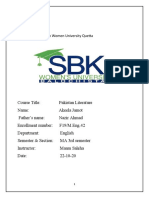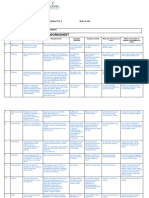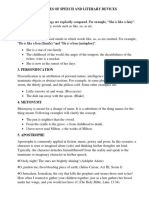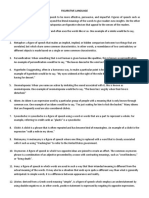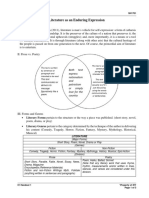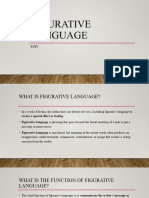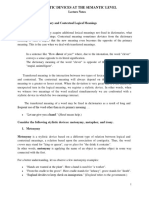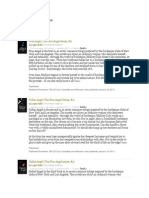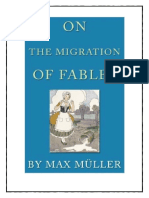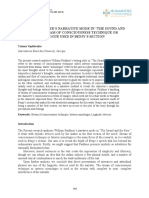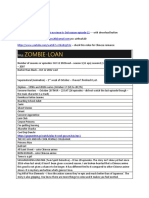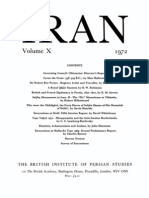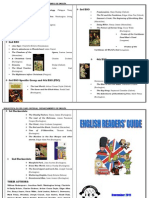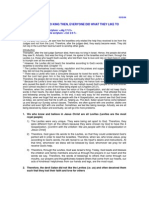Dr.
Rim Chakraoui ILL
Figurative Language: Literary Devices (Rhetorical Devices)
Figurative language uses figures of speech (such as similes, metaphors, and clichés etc.) to
suggest new pictures or images, or to create stronger effects. It is particularly useful in getting a
specific message or feeling across. For instance we say “It’s freezing” to talk about cold
weather.
Figurative language has a fundamental impact on readers. By creating new connections between
concepts, images or objects that have little to no original link, readers discover new insights and
see a more vivid or imaginative picture in their heads. Figurative language is also useful in
explaining an abstract concept by comparing it to something else that readers can better relate to.
It can transform the seemingly ordinary into something significant. “My heart flies when I see
you”
This is why authors of all genres employ figures of speech so abundantly. In literature and
poetry, writers often use them to pinpoint an exact feeling or mood they would otherwise fail to
express with more conventional wording. Politicians and debaters use figurative language to
argue and persuade. Novelists use it to draw readers into the world they’ve created.
Some Examples of Literary Devices Used in Figurative language.
1. Overstatement or Hyperbole or Exaggeration
An overstatement—otherwise known as hyperbole—uses extreme exaggeration for humorous effect.
Hyperboles are intentional and obvious exaggerations in order to emphasize or evoke strong feelings.
They aren’t meant to be taken literally.
Example: “I nearly died laughing.”
The student’s backpack weighed a ton.
2. Understatement
An understatement does the opposite of an overstatement, in that it is used to under emphasize a point
which you would normally expect to be more significant. It tends to get most of its humor through ironic
context, with a famous example being the scene in which the Black Knight in Monty Python and the Holy
Grail has each of his limbs cut off but says, “It’s just a flesh wound!”/ "I have a little bit of a temper."
3. Repetition
Repetition is one of the most vital ingredients in humor. The idea is that if you repeat something often
enough—a word or a phrase—eventually it will become funny
E.g., the name Ernest in the IBE
Algernon to Jack : What you really are is a Bunburyist. I was quite right in saying you were a
Bunburyist. You are one of the most advanced Bunburyists I know.
1
�Dr. Rim Chakraoui ILL
4. Puns
A pun is a play on the similarity of words to be funny.
E.g., A pessimist's blood type is always B-negative.
E.g., Earnest (= adjective meaning serious and sincere) and Ernest (male name)
e.g. it is in your genes/ it is in your jeans
5. Double Entendre or Double Meaning
As a kind of pun, of sorts, a double entendre is a word or phrase which initially has a relatively innocent
meaning has a double meaning.
6. Similes
A simile is a figure of speech that compares two things of different kinds, and that is often
introduced by using a connecting word such as like or as. Here are some examples of similes:
• She was as busy as a bee.
• The three-piece suit fit him like a glove.
• Your heart is cold as ice.
7. Metaphors
A metaphor is the same as a simile, but without the connecting word like or as. In a metaphor,
one element directly replaces the other one. Some examples of metaphors include:
• “Hope is a thing with feathers” Emily Dickinson
• She was a busy bee.
• His eyes were a deep ocean.
• You are an iceberg.
8. Cliché
A cliché is a phrase, expression, or idea that has become so overused that it has lost its original
meaning or effect. Clichés can sometimes be seen as irritating and annoying because of their
predictability. Here are some classic examples of clichés:
• You are as beautiful as the moon.
9. Idioms or idiomatic expressions
An idiom is a group of words that, when used in a certain order, have brand new, unique
2
�Dr. Rim Chakraoui ILL
meaning that has nothing to do with the definition of the words taken individually. Idioms are
generally used to reveal a universal truth.
Here are some examples of useful idioms:
• The project was a piece of cake= easy
• “It cost an arm and a leg.” = expensive
• Like a kid in a candy store = happy
• “You can’t judge a book by its cover.”
10. Onomatopoeia
It’s the formation of a word by imitating the sound the thing it refers to makes or evokes. You
can find them in most nursery rhymes.
• The cow goes Moo.
• Ding dong/ Tick tok = (verb ) tick/ to buzz (bees) / to beep
11.Personification
Personification is when human characteristics or qualities are attributed to inanimate objects,
animals, or abstract concepts. Some examples of personification:
• The wind screamed in the night.
• The camera loves her.
• My alarm clock yells at me to get out of bed every morning.
12. Oxymoron
An oxymoron associates two contradicting words or concepts to illustrate a Taken
independently, bitter and sweet mean opposite things; however, their association (bittersweet)
create a distinct, highly evocative meaning. Here are some other examples of oxymorons:
• “Parting is such sweet sorrow”—William Shakespeare, Romeo and Juliet
• The silence was deafening.
• I was busy doing nothing.
• Original copy
• Old news
• Love is suffering.
• Awfully good
• bittersweet
13. Euphemism
A euphemism is when a polite or mild word or expression is used in place of something more
unpleasant, distributing, or taboo. In this regard, it functions as the opposite of hyperbole.
E.g., He ‘passed away’= died
I am between jobs. = unemployed
Prison= it's a “correctional facility.”
Our company is downsizing = firing employees
14. Allusion
3
�Dr. Rim Chakraoui ILL
An allusion is a device that makes the reader think of another person, place, event, or thing
outside of the text. Allusions can be either explicit or implied in the narrative. Some of the most
common sources of allusions in English come from the Bible and Greek mythology.
• The girl couldn’t stop eating sweets; they were her Achilles’ heel = weakness
• This place is heaven to me = allusion to Garden of Eden al Jannah Adan in
Coran /Bible
15. Taboo
Any subject which is socially not acceptable, forbidden or disapproved of
E.g., politics, sexuality etc.
16. Mistaken Identity
When identities are mixed, a comic effect is created.
E.g., Banbury
Jack, Ernest, Algernon
17. Caricature
This is a character that uses a distorted or exaggerated version of a person’s features or personality to
create a comic effect.
18. Irony
Is a literary device or event in which how things seem to be is in fact very different from how
they actually are. Irony is a broad term that encompasses three different types of irony, each with
their own specific definition: verbal irony, situational irony and dramatic irony: ↓
1.Verbal Irony:
The speaker says one thing, but they really mean another, resulting in an ironic clash between
their intended meaning and their literal words. Saying the opposite of what we mean.
4
�Dr. Rim Chakraoui ILL
E.g., On the way to school, the school bus gets a flat tire and the bus driver says, "Excellent!
This day couldn't start off any better!"
2.Situational irony:
Involves a situation where an outcome is different than what you might expect. For example,
Lady Bracknell does not want her daughter, Gwendolen, to marry Ernest, even though he is
wealthy and has a good reputation. Instead of Lady Bracknell focusing on Ernest's good
qualities, she only focuses on a minor issue that Ernest cannot control: his family background.
On the other hand, Lady Bracknell is happy for Algernon to marry Cecily when she discovers
that Cecily is wealthy even though she is Jack's ward.
3.Dramatic irony:
Is a plot device often used in theater, literature, film, and television to highlight the difference
between a character's understanding of a given situation, and that of the audience. More
specifically, in dramatic irony the reader or audience has knowledge of some critical piece of
information, while the character or characters to whom the information pertains are "in the
dark"—that is, they do not yet themselves have the same knowledge as the audience. When we
know more than the characters themselves.
19. Satire
Is the use of humor, irony, sarcasm, or ridicule to criticize something or someone. Public figures,
and politicians are often the subject of satire, but satirists can take aim at other targets as well—
from societal conventions. Satire is an entertaining form of social commentary, and it occurs in
many forms: there are satirical novels, poems, and essays, as well as satirical films, shows, and
cartoons.
Alec Baldwin's impersonation of Donald Trump on Saturday Night Live is an example of satire.
*Both a device (technique used) and genre ( a piece of writing using satire).
